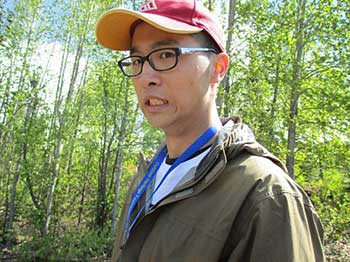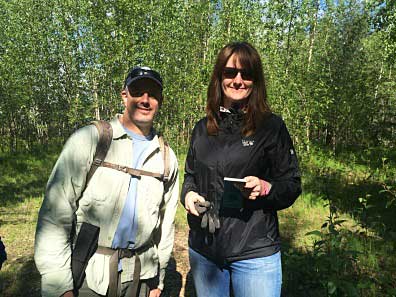Alaska Fish & Wildlife News
June 2015
“How can I get a job like that?”
Internships in Wildlife Education & Outreach

“How can I get a job like that?”
I hear this several times a year as I connect with students across the state. The better-known internships for Fish and Game include fish counters or gear wranglers for the field season. What‘s often overlooked are the opportunities involved in communicating with the public. The Wildlife Education & Outreach Program engages Alaskans in a variety of ways, and interns with the program come away with valuable experience.
Our outreach targets hunters, trappers, anglers, teachers, kids, and Alaskans in general. Our work includes “bear awareness” and safety, “living with bears” skills (such as how to set up an electric fence around a chicken coop), teaching about salmon and wildlife and their importance to Alaskans, and connecting Alaskans to the outdoors. We produce a wide array of publications related to hunting and wildlife management (such as the guides “Mountain Goat Identification Quiz and “Brown Bear: Identifying males and females in the field”); we organize classes; participate in events such family fishing days; and produce (or help produce) workshops such as Becoming an Outdoors Woman and Alaskans Afield.
Interns with the Wildlife Education & Outreach Program learn about Alaska and the nature of Alaskans, matching the content of the material or event to the age and skill levels of the participants and to the bioregion of the community. They learn to understand their audience and their needs.
We engage all modes of communication; written, verbal, web and video, drama and radio. This diversity allows us to tap into the talent of students majoring not only in biology, but in English, environmental education, rural development, society and the environment, ecology, and education. We work with the university systems to solicit undergraduate interns that have experience interacting with the public, working with youth, connecting people with the outdoors. We are particularly interested in those who are willing to try something new and perhaps outside of their comfort zone.
This was the case for the Anchorage office intern Yan Ching Liu. Yan, a student of Society and the Environment from University of Alaska, Anchorage was accustomed to speaking in front of groups as a campus tour guide. His booming baritone voice commanded attention. His ability to patiently explain complicated concepts to all ages, along with his quick smile, willingness to help, and his experience teaching children Kung Fu won him his position as our first intern. Yan had no idea what was lying in wait for him, tasks like wandering around the Governor’s picnic sharing ‘be bear aware’ messages in a full blown bear suit, all while shaking hands and getting hugged. Yan was unaccustomed to the throngs of small children that would be clinging to his legs as they had their picture taken with a ‘bear’ at the picnic or dealing with kindergarten students as they learned how to play a game about migrating salmon. The game called for some salmon to die as part of their lifecycle and sit on the sideline temporarily. If you don’t have a lot of experience with early childhood students you might not realize the devastation of ‘dying’ for a 5-year-old. Yan melted a little bit as the little guy cried real tears in his disappointment. He quickly learned to let students know they will be able to play again in the next round, they weren’t really going to die.
When asked about his learning experience Yan noted, “The one thing I felt like I've learned the most was being observant of the work being done at ADFG. I really enjoyed watching Brenda and Elizabeth give presentations to different audiences changing the way information was presented based on the audience’s needs, age and prior knowledge. When I was giving a presentation to a group of students coming to visit ADF&G, I tried to imagine how Brenda and Elizabeth would present it and try to also add my own style into it. One of the most surprising (and maybe also interesting!) experiences I found was how much cooperation there was with other agencies and non-profit groups such as NPS, State Parks, BLM Campbell Creek Science Center. There is a friendliness, a willingness to help each other out to achieve shared goals. With a simple phone call or email, people are happy to help out any way they can.”

Kelsie Huyer-Dougherty in the Fairbanks office was a tremendous help to our staff as she took on the project of writing and designing the division’s magazine for kids, Alaska’s Wild Wonders, Wetlands edition. The wildlife education staff is a tight knit bunch and we endeavor to reach the highest quality education products and programs. Sometimes the collective review of a project can be a little ‘overly direct.’ We know each other well enough not to take offense and Kelsie endured her first critique bravely, but not without some wounds. Kelsie came out of the experience with thicker skin and we ended up with another superb edition that teachers still rave about.
Kelsie remarked, “My experience as an education and outreach intern at ADF&G was one of the most beneficial learning experiences of my college career. The most important experience for me was learning how to collaborate with a team of educators across the state to produce education and outreach materials. The most interesting part of my internship was the people that I was able to work with. The biologists and educators were my most valuable resource and were happy to answer questions and help make my internship a great learning experience.”
Adrienne Smyth, another Fairbanks intern, was an English major, minoring in Natural Resources Management, who took over the development of a Teacher’s Guide to accompany a fur kit. Mike Taras, the Region III Wildlife Educator and her supervisor noted, “I was fortunate to have interns that were mature and they had some previous experience. They learned quickly and most importantly they could write and communicate well. This helped me out a great deal, because I used their skills to edit and review my materials, but at the same time they learned how to pick out the most important facts and to distill information. They both managed to create some wonderful and very useful materials for teachers and the general public.”
Both interns also helped teach workshops and present at events such as the annual ‘Fishing is Fun Day’ where hundreds of residents visit the activities set up at Creamer’s Field State Game Refuge. Keeping your smile and patience after you’ve answered a thousand bear questions is a skill (in patience) indeed.
Adrienne Smyth noted: There is no boring day in the world of wildlife education. I had many memorable work experiences—camping, tracking wildlife, being dive-bombed by birds, preparing animal specimens for educational kits, acting like a beaver, answering the funniest and strangest bear questions, and learning more about scat than anyone would ever want to know!
My internship with the Division of Wildlife was exceptionally helpful to me. It not only gave me experience to bolster my resume, but also confidence as a professional. I highly recommend the ADF&G Internship Program to any student with interests related to any of the divisions.
A unique skill set
A wildlife educator needs a unique set of tools; communication (strong writing, editing, verbal), interpersonal, planning, graphic design, knowledge of teaching methods/standards, science, cultures, patience, resource management, networking, marketing, place-based education and more. As the seasons change, so do the messages to the public and the method of delivery. We recognized the need for a video to demonstrate how to install electric fences to protect chickens from bears. Early in the spring food is a bit more scarce for newly awakened bears, and chickens are, well, ‘Finger lickin’ good looking,’ to a bear. We needed someone to develop a series of short videos on the topic of electric fences to protect chickens. When interviewing prospective interns through the hiring process Alex Ede, a senior at UAA, sent us an impromptu iPhone movie on the importance of picking up dog poop. It was simple, clever and delivered a single direct message that hit home; just what we were looking for! After accepting the position Alex set forth to draft the script, set the scene and begin filming the first video. Challenges included cornering the biologists chosen to deliver the messages, because just when a shooting date was set, the biologists would get a call about a problem bear, the next day it would rain or some other obstacle would overtake the shooting schedule. Alex said the editing process was the most tedious portion of this project. He really had no idea how very long it would take to edit out the information that wasn’t pertinent or attractive. Add to this the fact that Alex wasn’t familiar with the software used at Fish and Game and had to learn to use it before any exclamation of Action! could occur, a feat in itself. This revelation alone helped Alex understand his strengths and interests and helped our staff build a better timeline for creating a video product.

Today, Lynda Jones in the Douglas office is toiling over the next edition of Wild Wonders, all about the Bears of Alaska, a topic a biology major can really dig into. When it comes critique time, we’ll gather our comments and deliver them so Lynda will know we have the best intensions of creating a really useful teaching too. We can’t wait to see what she comes up with. She’ll also be teaming up with Tennie Bentz, the SE regional wildlife education specialist to give bear safety presentations in the schools this spring and presenting a Citizen Science workshop on Prince of Wales Island on wolves. She’s looking forward to this learning opportunity.
But what about that job?
While not every intern earns a full time position with Fish and Game, they add to their resume a host of experiences with a credible group of professional educators. They gain experience working at a State agency, learning its procedures, policies, processes, etc., a benefit to anyone shopping for a position after graduating from college. From their experiences we hope Biology students learn how to effectively communicate scientific information to diverse audiences, that Society and the Environment students see the many ways they can connect the public with research that touches the lives of people in Alaska, that Education students (future teachers) experience the benefit of using the outdoors as an extension of their classrooms and the many educational resources ADFG offers to teachers across the state and nation. As students mature into the workforce, we strongly believe the mentorship of professionals in the field not only guides them on their current path, but may help them to find other ways of seeing and knowing what that path could look like and their potential impact on the future of our state. We look forward to working with more students in the future.
To learn more about Fish and Game internships, log onto the Workplace Alaska website.
Brenda Duty is the Project WILD and Youth Education Coordinator. She works statewide, but her office is in Anchorage. Brenda.Duty@alaska.gov 907-267-2216
Subscribe to be notified about new issues
Receive a monthly notice about new issues and articles.
